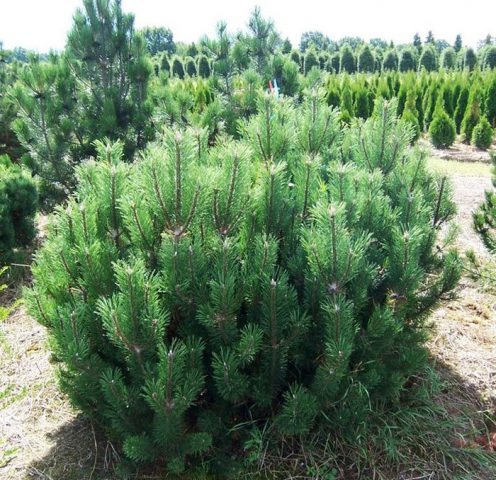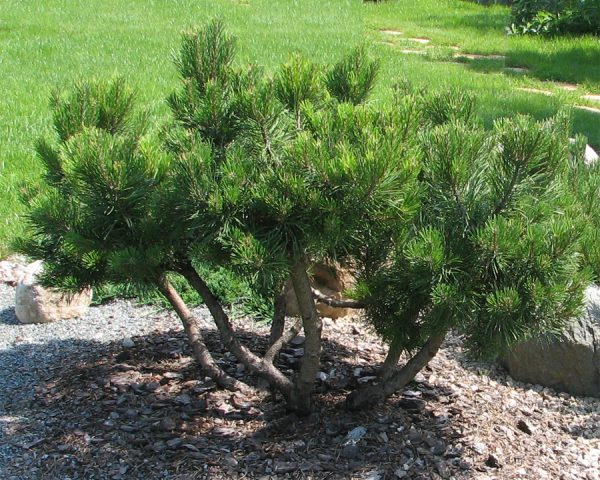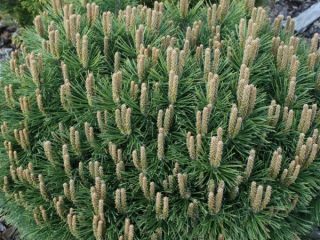Content
Mountain pine is common in Central and Southern Europe; in the Carpathians it grows higher than other coniferous forests. The culture is distinguished by its extraordinary plasticity; it can be a shrub with several ascending trunks or one short dwarf tree topped with a pin-shaped crown with geniculate shoots. Mountain Mugus pine is one of the natural forms often used in landscape design.
Description of the mountain pine Mugus
Mountain pine Mugo var. Mughus is not a variety, but a subspecies, so its form is stable, and all specimens are similar to each other. It is a creeping shrub with elbowed branches and ascending shoots.
Mugus grows very slowly, more in width than in height. An adult shrub usually reaches 1.5 m with a crown diameter of up to 2 m. Young shoots are smooth, green, then become gray-brown. The old bark is gray-brown, peels off in scales, but does not fall off, it simply becomes dark brown, which is the species characteristic of mountain pines.
The needles are dark green, very thick, hard, can be smooth, partially or completely twisted, length - within 3-8 cm. The needles are collected in 2 pieces and live from 2 to 5 years.By the way, this is an indicator of the health of mountain pine. The longer the needles stay on the bush, the more comfortable the plant feels. Severe needle drop is a sign of trouble; you need to urgently look for and eliminate the cause.
The cones are symmetrical, after ripening they look down or to the sides, are attached directly to the shoots or hang on a short stalk, and ripen at the end of the second season. In the autumn of the first year the color is yellow-brown. Once fully ripe, the color becomes the same as cinnamon. On one mountain pine, the cones are the same size, and the scaly shields are also keeled. Only in the lower part are they flat, and in the middle - with a growth, often equipped with a spine.
The root of the mountain pine Mugus goes deep into the ground. Therefore, the crop can be used as a soil-protective crop, withstands drought well, and grows on any soil. In nature, Mugus often grows among stones, on the edge of cliffs, with the crown literally hanging in the air. It stays there only thanks to its tenacious, powerful root.
Although the homeland of the mountain Mugus pine is the Balkans and the Eastern Alps, it grows without shelter in the second zone and can withstand frosts down to -45° C. If properly maintained, the shrub will live in one place for 150-200 years.
Mountain Mugus pine in landscape design
Thanks to the shape of the crown and more than modest size, Mugus pine seems to be intended for growing in Japanese gardens. It looks good in rock gardens, rock gardens and other compositions among stones and boulders.
Mugus tenaciously clings to the ground with a powerful root, it can be planted on any sloping areas, and if the owners have enough money, even used to strengthen crumbling and sliding slopes. Often the culture decorates the terraces or the front entrance to the house.
Mountain Mugus pine is grown in flower beds with flowers that do not require moisture, among small roses. It will decorate the foreground of large and small landscape groups.
It’s just that designers don’t use it as a tapeworm - the Mugus pine is small, and it wins in group plantings. Even if its neighbors are other conifers.
Mountain pine Mugus looks great in the company of:
- heathers;
- cereals;
- roses;
- other conifers;
- ground covers;
- peonies.
The culture can be planted even in the smallest garden, and always attracts attention.
Planting and caring for mountain pine Mugus
When caring for Mugus pine, you should take into account that in nature it grows high in the mountains. This is not an artificially bred variety, but a subspecies. Comfortable conditions for the bush will be those that are as close to natural as possible.
Mugus prefers moderately fertile, well-drained soils. But it tolerates somewhat compacted and poor soils. In a place where there is constant water, the mountain pine will die.
Mugus grows well in bright light. A light shadow is acceptable, but not desirable. Winter hardiness – zone 2. Resistance to anthropogenic pollution – satisfactory. This means that pine cannot be planted near factories, parking lots, and highways.
A shrub in places where groundwater comes close to the surface will grow only with good drainage, and even better - on an artificial embankment.
Preparing seedlings and planting area
Mugus mountain pine seedlings should only be taken in containers. Even if the root is dug out with a ball of earth and covered with burlap. It goes deep into the ground, the plant itself is small, its age is difficult to find out. It is possible that the root was damaged during digging.But replanting pine trees can only be tolerated normally for up to 5 years, then there is a high probability that they simply will not take root.
When buying a shrub, you need to pay attention to the needles. The more years the needles have been preserved, the better the quality of the seedling.
This means that not all is well with the seedling. He is “on the brink”, and planting in new conditions, even a container plant, is still stressful.
A hole for Mugus is dug in 2 weeks or less. Recommended substrate: turf soil, sand, clay, and, if necessary, lime. Gravel or sand can serve as drainage. What cannot be added when planting is humus of animal origin.
A hole is dug to such a depth that at least 20 cm of drainage and a root can fit there. Width - 1.5-2 times larger than an earthen clod. Drainage is poured into the planting hole, the remaining volume is filled 70% with substrate and filled with water.
Landing rules
Container-grown mountain pine can be planted all season long. But in the south in the summer it is better not to do this. Preference should be given to spring planting in cold and temperate climates, and autumn planting in warm or hot climates.
The main thing when planting mountain pine Mugus is to carefully measure the position of the root collar. It should coincide with the ground level, or be 1-2 cm higher. If you raise it by 5 cm, acceptable for other varieties, it will not end well. Mugus is a real dwarf, this is too much for her.
Planting process:
- A part of the substrate is taken out of the pit.
- Place the seedling in the center and measure the position of the root collar.
- Add soil in layers, thoroughly compacting it so that voids do not form.
- Watered.
- Mulch the tree trunk circle.
It is better to use coniferous tree bark purchased at a garden center as bedding. It is sold already processed; it is impossible to introduce pests and diseases with it. That is why pine litter or bark collected independently in the forest cannot be used for this purpose.
Peat, rotted sawdust or wood chips can be used as mulch. Fresh ones will rot right on the site, generate heat, and can destroy any plant.
Watering and fertilizing
Mountain Mugus pine requires frequent watering only for the first time after planting. In the future, they can only damage the culture. This variety is very resistant to drought and does not tolerate waterlogging.
Young plants (up to 10 years of age) are watered once a week in hot summers. Mature ones - no more than once a month, but at the same time they consume about 50 liters of water for each specimen.
Fertilizing must be applied only to young pines (up to 10 years): in the spring with a predominance of nitrogen, in the fall - potassium-phosphorus. Adult specimens are fertilized only when growing in unfavorable conditions. For example, in an industrial center.
But foliar feeding, especially with a chelate complex with the addition of magnesium sulfate and epin or zircon, is desirable. They not only compensate for the lack of microelements, but also increase the resistance of mountain pine to unfavorable conditions, including air pollution.
Mulching and loosening
The soil under the Mugus mountain pine needs to be loosened only in the first two years after planting.This operation breaks the crust that forms on the soil after rains and watering, and allows the roots to receive the necessary oxygen, moisture, and nutrients.
In the future, they are limited to mulching the soil, which retains moisture and prevents germination. weed, creates a suitable microclimate.
Trimming
Mugus pine grows slowly and only needs sanitary pruning. You can increase its decorative value by pinching off 1/3 of the young growth in the spring. But the culture is beautiful even without crown formation. Of course, if you wish, you can create something original using trimming, as in the photo.
Preparing for winter
Only young plants need shelter for the winter for the first, and in cold regions, the second winter after planting. To do this, it is enough to mulch the soil with a thick layer of peat, and wrap the mountain Mugus pine with white non-woven material, or place a cardboard box with holes made in advance on top. It is important to somehow secure it so that the wind does not tear it off.
Then the mountain pine will winter well under the snow.
Reproduction
Those who like to propagate the Mugus mountain pine can only use seeds. This is not a variety, and all seedlings, if they can be brought to planting in a permanent place, will be highly decorative.
But without a specially equipped room, this is extremely difficult to do. In addition, caring for young plants takes a lot of time. So the seedlings will constantly die, and they are unlikely to survive to 5 years of age.
Cuttings of pines, including Mugus, usually ends in the death of the rooted shoots. The culture can be propagated by grafting, but this operation is not for amateurs.
Diseases and pests
Pine trees often get sick and are affected by pests.Against their background, mountainous Mugus looks like a model of health. But only if planted in the right and environmentally friendly place.
Among the pests of mountain pine are:
- pine Hermes;
- pine aphid;
- common pine scale insect;
- pine moth;
- pine cutworm;
- pine shoot silkworm.
When caring for mountain Mugus pine, you may encounter the following diseases:
- pine blister rust (seryanka, tar cancer);
- rot caused by waterlogging of the soil.
At the first signs of disease, mountain pine is treated with fungicides. It would seem that all you have to do is adjust the watering, plant the bush in the “right place,” and there will be no problems. But this is not true, unfortunately. Rust creates a lot of trouble for gardeners.
Pests are destroyed with insecticides. To avoid problems, you need to carefully inspect the pine tree, carefully moving the branches apart with clean hands.
Conclusion
Mountain pine Mugus withstands air pollution better than other members of the genus. Its decorative nature and small size make it possible to plant the crop in large gardens and small front gardens, and if chosen correctly, it does not take much time to maintain.














